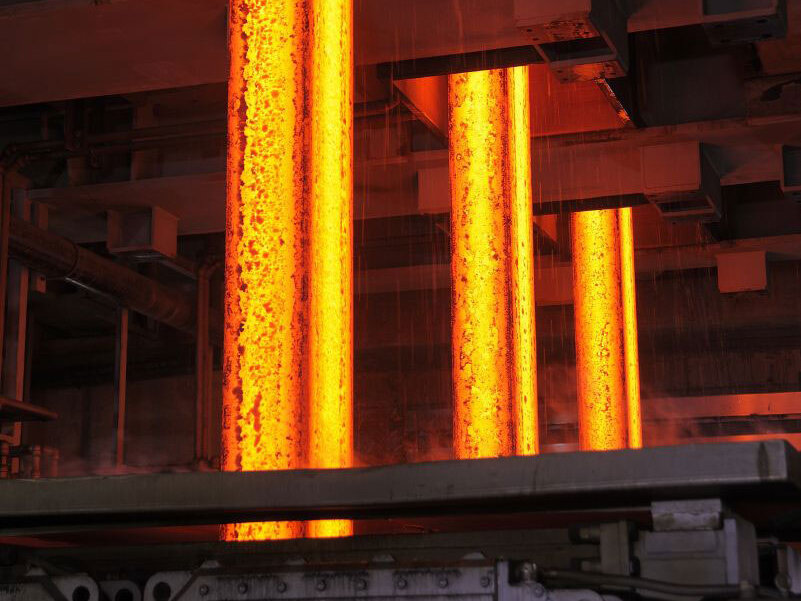Vertical Continuous Casting Plant (VCCP)
Change the way you cast - A break through in technology for strip casting of copper & copper base alloys.For the first time in India, Kalpatech Engineers, backed up by over two decades of experience in the field of copper and copper alloys smelting / refining / melting and various types of casting such as conventional, down casting, semi continuous casting, and horizontal continuous casting plants, have successfully developed Copper Strip Casting up to 620 mm width with Vertical Continuous Casting Plant ( VCCP ).
Despite the proven superiority by far of VCCP over HCCP, VCCP has thus far been successful only for rod castings. For strip castings, however, particularly for strips with larger widths, such as 400 to 620 mm. VCCP has always had a very major problem caused by the Surface Tension of the molten charge while being drawn upward through the die. This, more often than not, results in non-uniform width strips with voids and porosity. The problem is further aggravated due to the density difference between the molten charge and the solidified metal and the rather slow rate of cooling that conventionally designed heat exchangers accord to the molten metal for solidifying in the die. M/s. Kalpatech Engineers have successfully dealt with the above & developed VCCP for casting of OFHC copper & copper base alloys. This casting is also very successful in casting of Zinc & Zinc based alloys & Aluminum & Aluminum based alloys.
The Salient Features of the VCCP developed by Kalpatech Engineers & Industries Ltd. are:
The surface tension problem effectively addressed by innovative technology for wider width. ( Patent Pending).
- Controlled and pressurized high velocity water flow coupled with spinner heat exchangers to give a very high cooling effect to molten charge when it enters the die.
- State-of-the-art secondary cooling system.
- State-of-the-art water battery design
The withdrawal machine is located above the holding furnace. The die cooler is fastened to it so that the die can be immersed to a certain depth in to the melt.
The dies are kept at certain depth with an automatic height position control system which regulates the down and up movement of the machine according to the metal level in the furnace.
The strip is guided via an automatic speed control equipment to the coilers. The coiling speed is synchronized to the casting speed. When the desired weight of coil is ready the strip can be cut and the coil is lifted away.
The casting machine is designed so that it can be operated by three men / shift, which includes a Supervisor.

The Advantages of using the Servomotor are :
Withdrawal machine (servo motor) is controlled through PLC operated Scada system using the control desk or the control panel of the caster. The casting speed and the parameters for different alloys and different sizes of the strips can be given and accordingly the speed can be adjusted depending on the casting requirement of different alloys. Also the temperature and flow of the cooling water are measured. These values can be read from the display of control desk.
- Control on parameters such as pull length, Pull time.
- Push back can also be given to get the desired surface and quality..
- Accurate data will be available for evaluation.
Advantages of VCCP
It is an acknowledged fact that in casting of copper and copper base alloy rods, the rods cast through Vertical Continuous Casting Plants (VCCP) have better quality vis-à-vis rods cast through Horizontal Continuous Casting Plants (HCCP) in terms of ductility, cold-work ability on as-cast rods and casting soundness.
Apart from the qualitative superiority that VCCP castings have over HCCP castings, the constructional structure of the VCCP accords a lot many other advantages over the HCCP. To name but a few –
- Operating Efficiency of VCCP is more than 95% against 70% of HCCP. The efficiency of HCCP further falls to 50% to 60% in case of high temperature alloys such as Cu Ni / Ni silver copper where die life is very short.
- Die change takes hardly 35 min in case of VCCP as against the few hours that are required in a HCCP.
- No Furnace mouth repairs required in VCCP.
- No metal run-outs either through Furnace and die interface or through die. These run-outs of molten metal cause heavy damages to the HCCP and also invariably culminate in very long production shutdowns.
- Highly simplified and risk free operation in VCCP.
- Very high rate of output i.e. almost 50% to 67% (i.e.2/3rd) extra production compared to HCCP.
- Very low electrical consumption on holding Furnace owing to the least possible cooling effect transferred from die assembly. In case of OFHC copper electrical consumption of the entire plant is less than 500 KWH per MT.
- Perfect solution for high temperature alloys that have low die life and are prone to run-outs such as Cupro Nickel, Nickel Silver & Phos-Bronzes.

- In VCCP, even when the furnace is full, die change can be effected WITHOUT being required to empty out even a Kg of molten metal unlike in the HCCP where drain out to below the die level is a necessity. This yields saving in not only the electrical consumption but also the melting loss that the entailed double melting causes.
- High conductivity Copper i.e. either ETP or OFHC cannot be cast at all using HCCP (ETP cannot be cast using any continuous casting owing to Graphite die erosion & OFHC cannot be cast as the oxygen cannot be kept under control in case of HCCP). It is great advantage of VCCP that the OFHC copper can be cast only & only using this process i.e. VCCP.
High Quality VCCP Strip Casting of Copper and Copper Base Alloys is now possible due to this breakthrough technological development.

